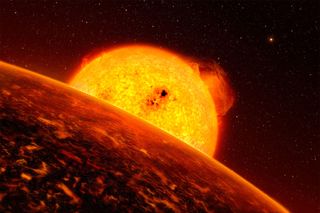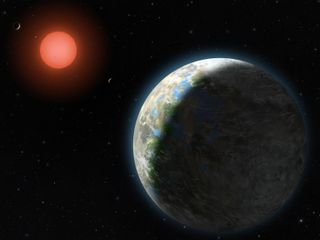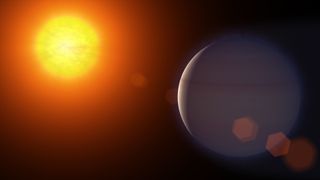What Would A Rocky Exoplanet Look Like? Atmosphere Models Seek Clues

When a distant planet appears as a point of light in a telescope, it's hard to imagine what things are like at the surface. Does rain fall? Is the atmosphere thick, or dissipating into space? How constant is the sunlight on its surface?
Telescopes today are only just beginning to answer that question and get us closer to understanding where extraterrestrial life might exist. As planets transit across the face of their stars, it's possible for astronomers to figure out what chemicals are contained in the planet atmospheres, and to make predictions. However, until now only hot giant planets are observable.

Francois Forget, a senior research scientist with the Meteorological Dynamics Laboratory of the Pierre Simon Laplace Institute in Paris, is part of a group trying to create a model for how planetary atmospheres behave on smaller, rocky planets like Earth, based upon observations in our own solar system. He acknowledges it is limited – we know little about such planets farther in the universe – but the model is a start to learning more about other planets. [The Strangest Alien Planets (Photos)]
"It's very ambitious," Forget said. "It’s designed in a way so we can simulate, as much as we can, a planet with any kind of atmosphere around any kind of star, and with this tool explore the range of planets we can have."
His latest work concerning climates on terrestrial exoplanets, carried out with his colleague Jeremy Leconte, is a synthesis of this experience, along with a survey of the research literature. The paper, called "Possible climates on terrestrial exoplanets", is available right now on the pre-publishing site Arxiv, and in press with the Proceedings of the Royal Society.
The "punchline" of the research, as Forget put it, is what factors control the composition of a planet's atmosphere. Studying all sorts of planets will help scientists learn more about life and habitability in distant worlds.
Life in strange places
What is the climate on a planet – and in particular how life-friendly it is- depends on three factors: the atmospheric composition (including the presence or absence of an ocean), its parent star's variability, type and distance away from the planet, and the type of planetary rotation.
This can lead to life in unexpected places. Perhaps a star is smaller and weaker than our own sun, but the planet is at a shorter distance than the Earth is to its sun. Since that star's rays have a shorter distance to travel to the planet's surface, they could warm it to a similar extent as the sun does on the Earth.
Or maybe a planet is roasting right next to a star, tidally locked so that the perpetual day-facing side is too hot to support life. On the night side, however, the atmosphere surrounding the planet could permit pockets of liquid water.

These are all scenarios that Forget and Leconte are considering. A key figure in their paper looks at the different types of atmospheres that are possible depending on the mass of the planet, and its temperature. [9 Exoplanets That Could Host Alien Life]
"This is very highly speculative brainstorming on what kind of cocktail of atmosphere we can have on a terrestrial planet," Forget said. "We don’t know quantitatively where we should put the boundaries between the various types of atmospheres. Also, keep in mind the physical processes that actually control the composition of the atmosphere are extremely difficult to model and simulate and calculate."
The research, however, shows that different kinds of planets tend to have specific sorts of atmospheres.
A gas giant, for example, is so huge that its gravity can hold on to the light elements of hydrogen and helium, which were likely the original elements in the solar system when the sun and planets were just coming together from a gas cloud. Earth likely had these elements in abundance in its atmosphere at the beginning, but lost them over time as the planet's mass is much smaller. A recent Nature Geoscience paper also showed that Mars likely had hydrogen in its atmosphere when it was young.

"The star light heats up the water, putting more water vapor in the atmosphere, which enhances the greenhouse effect and amplifies the heating," Forget said.
Eventually, all the oceans can be vaporized. Because the Sun's luminosity increases with time, this will eventually happen to the Earth. Fortunately, not for another billion years, according to another recent study by Leconte and Forget. Venus being closer to the Sun, received even more sunlight, causing the hydrogen and oxygen atoms contained in the water to escape and leaving carbon dioxide molecules behind; this created Venus' notoriously thick and stifling atmosphere. [See photos of Venus]
Planets farther away from a star similar to our sun (say, at Jupiter's distance) would see the carbon dioxide freeze out and collapse on to the surface, although nitrogen can still remain until planets are beyond the equivalent distance of Neptune in our own solar system.
Glancing at Gliese 581
As Forget's team refines the model it is also applying the research to current exoplanet discoveries. One notable set was several planet candidates found in recent years around Gliese 581, which is about 20 light-years away.
Astronomers initially felt that Gliese 581c was potentially habitable, but changed their minds after follow-up research, Forget explained. "Initially, the astronomers were very excited about 581c, but very quickly they interacted with climatologists like me who said it cannot be habitable. It is way too close to the star and there will be a runaway greenhouse effect," he said.
A United States-led team discovered Gliese 581g in the center of the star's habitable region, but that planet has been called into dispute by others who said the discovery was a fluke in the data and not an actual planet. Another planet, Gliese 581d was thought to be too cold as it receives less than a third of the stellar energy Earth does while being so close to its dwarf star that it is likely tidally locked, with one side perpetually facing the star. (That's similar to how the moon's rotation behaves around Earth, Forget pointed out.)
Get the Space.com Newsletter
Breaking space news, the latest updates on rocket launches, skywatching events and more!
"With another member of the team, Robin Wordsworth, we applied our model to the planet and found it was quite easy to show that, with a reasonably thick atmosphere, it still has warm enough temperatures for liquid water, so it's not impossible that it was habitable," he said.

As for Gliese 581c – the planet that initially excited astronomers – Forget and Leconte are not altogether ruling out habitability. There could be different climate regions on the planet, with a spot at the edge of the night side still cool enough for liquid water.
Two motivations drive Forget's team to learn more. The first one is to prepare for observations for a time when telescopes can pick out more about small exoplanet atmospheres, whatever they are: hot, temperate, or very cold. Also, they hope to "make progress on these never-ending questions on habitability, are we alone in the universe, and so on," he said.
"We have no observations at all about atmospheres on terrestrial planets, yet we know there are a lot of terrestrial planets everywhere; a very high fraction of stars have these planets," he added. And when those results come in, Forget's team hopes to be ready to learn more about if life could exist in those places, and how.
This story was provided by Astrobiology Magazine, a web-based publication sponsored by the NASA astrobiology program.
Join our Space Forums to keep talking space on the latest missions, night sky and more! And if you have a news tip, correction or comment, let us know at: community@space.com.

Elizabeth Howell (she/her), Ph.D., is a staff writer in the spaceflight channel since 2022 covering diversity, education and gaming as well. She was contributing writer for Space.com for 10 years before joining full-time. Elizabeth's reporting includes multiple exclusives with the White House and Office of the Vice-President of the United States, an exclusive conversation with aspiring space tourist (and NSYNC bassist) Lance Bass, speaking several times with the International Space Station, witnessing five human spaceflight launches on two continents, flying parabolic, working inside a spacesuit, and participating in a simulated Mars mission. Her latest book, "Why Am I Taller?", is co-written with astronaut Dave Williams. Elizabeth holds a Ph.D. and M.Sc. in Space Studies from the University of North Dakota, a Bachelor of Journalism from Canada's Carleton University and a Bachelor of History from Canada's Athabasca University. Elizabeth is also a post-secondary instructor in communications and science at several institutions since 2015; her experience includes developing and teaching an astronomy course at Canada's Algonquin College (with Indigenous content as well) to more than 1,000 students since 2020. Elizabeth first got interested in space after watching the movie Apollo 13 in 1996, and still wants to be an astronaut someday. Mastodon: https://qoto.org/@howellspace

